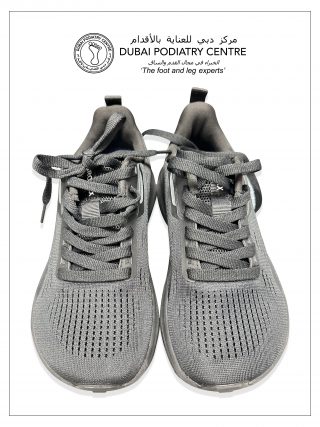Blisters – To Lace or Not?

Written by Michelle Champlin BSc Pod., M.Ch.S., S.R., Ch., (UK) Many of us have, or will experience a blister at some point in life, whether it be due to those new shoes or during a period of activity.
Blisters, a common injury, are painful fluid filled lesions, caused by friction and shearing forces. Frictional forces, that occur on various sites of the foot, cause separation between the epidermal layers (the top layer of our skin), and this space then fills with fluid.
Blisters can be caused by: ill fitting footwear, ill fitting socks, new shoes and foot anomalies. Blisters occur frequently amongst the vigorously active and are one of the most common injuries sustained by runners.
TREATMENT: To lance or not to lance?
Small, intact and pain free blisters should be left alone, especially if they occur during activity or mid race. The overlying skin will act as a protective covering, to remove this and continue applying increase force (as in any sports) will result in greater pain.
The best solution in this case would be to Protect and Deflect. Use a donut shaped pad to deflect pressure away from the blister. Dubai Podiatry Centre also provides a specialist fleece padding which can be cut to size, which is adhesive and specifically prevents friction and blisters – we recently used it for Extreme Marathon runner John Woods whilst competing in the Marathon De Sables through the Sahara Desert, and the padding entirely prevented friction from the inevitable sand in the trainers causing extreme blistering, which has been known to occur to debilitating extremes in other competitors.
Large and painful blisters can be lanced, post activity, using a sterile needle. Firstly cleanse the skin with alcohol or betadine solution and then gently pierce a small opening at the edge of the blister. Lightly press the fluid towards the open area, allowing the blister to drain fully. Do not remove the overlying skin, the roof should always be left intact, and the area covered with a sterile protective dressing.
If sepsis (infection) or dirt gathers below the roof of the blister, then you should seek podiatric treatment immediately.
PREVENTION is the key
You can reduce the incidence of blisters simply by wearing adequate fitting footwear and socks. Socks, preferably toe socks, will act as a protective layer between your feet and shoes, thus reducing the frictional forces on the skin. Plasters and other second skin products such as Compeed will also protect from such forces. The experts at Dubai Podiatry Centre have also specifically designed a blister-prevention pack for running, walking or hiking containing everything you need to stop hot spots turning into blisters. Remember also, that new shoes should fit well from day one – the need to ‘break in’ shoes is a myth!
If you are worried about your feet in any way, or are about to head off on a long hike, expedition or training routine, it’s advisable to have a lower limb assessment – contact us on +971 4 3435390.
بثور – لربط أم لا؟
بقلم ميشيل شامبلين
يعاني الكثير منا من البثور أو سيواجهها في مرحلة ما من حياته، سواء كان ذلك بسبب تلك الأحذية الجديدة أو خلال فترة من النشاط.
البثور، وهي إصابة شائعة، هي آفات مؤلمة مملوءة بالسوائل، ناجمة عن الاحتكاك وقوى القص. تتسبب قوى الاحتكاك، التي تحدث في مواقع مختلفة من القدم، في الانفصال بين طبقات البشرة (الطبقة العليا من الجلد)، ثم تمتلئ هذه المساحة بالسوائل.
يمكن أن تحدث البثور بسبب: الأحذية غير المناسبة، والجوارب غير المناسبة، والأحذية الجديدة، وتشوهات القدم. تحدث البثور بشكل متكرر بين الأشخاص النشطين بشدة وهي واحدة من أكثر الإصابات شيوعًا التي يتعرض لها العدائين.
العلاج: للرمح أم لا للرمح؟
يجب ترك البثور الصغيرة والسليمة والخالية من الألم بمفردها، خاصة إذا ظهرت أثناء النشاط أو منتصف السباق. سيكون الجلد المغطي بمثابة غطاء وقائي، وإزالته والاستمرار في تطبيق القوة المتزايدة (كما هو الحال في أي رياضة) سيؤدي إلى ألم أكبر.
الحل الأفضل في هذه الحالة هو الحماية والانحراف. استخدم وسادة على شكل ˜دونات™ لإبعاد الضغط عن البثرة. يوفر مركز دبي لعلاج الأرجل أيضًا حشوة صوفية متخصصة يمكن قصها حسب الحجم، وهي مادة لاصقة تمنع الاحتكاك والبثور على وجه التحديد – استخدمناها مؤخرًا لعداء الماراثون المتطرف جون وودز أثناء المنافسة في ماراثون دي سابل عبر الصحراء الكبرى، و تمنع البطانة تمامًا الاحتكاك الناتج عن الرمال الحتمية في الأحذية الرياضية مما يتسبب في حدوث تقرحات شديدة، والتي من المعروف أنها تحدث إلى أقصى الحدود المنهكة في المنافسين الآخرين.
يمكن وخز البثور الكبيرة والمؤلمة بعد النشاط باستخدام إبرة معقمة. قم أولاً بتنظيف الجلد بمحلول الكحول أو البيتادين ثم قم بثقب فتحة صغيرة بلطف على حافة البثرة. اضغط برفق على السائل باتجاه المنطقة المفتوحة، مما يسمح بالتصريف الكامل للفقاعة. لا تقم بإزالة الجلد المغطي، ويجب دائمًا ترك “السقف” سليمًا، وتغطية المنطقة بضمادة واقية معقمة.
إذا تجمع الإنتان (العدوى) أو الأوساخ أسفل سطح البثرة، فيجب عليك طلب علاج القدم على الفور.
الوقاية هي المفتاح
يمكنك تقليل حدوث البثور ببساطة عن طريق ارتداء الأحذية والجوارب المناسبة. تعمل الجوارب، ويفضل جوارب أصابع القدم، كطبقة واقية بين قدميك وحذائك، مما يقلل من قوى الاحتكاك على الجلد. كما أن اللصقات وغيرها من منتجات “الجلد الثاني” مثل Compeed سوف تحمي أيضًا من هذه القوى. كما قام الخبراء في مركز دبي لعلاج الأرجل بتصميم مجموعة خاصة للوقاية من البثور للجري أو المشي أو المشي لمسافات طويلة تحتوي على كل ما تحتاجه لمنع تحول النقاط الساخنة إلى بثور. تذكر أيضًا أن الأحذية الجديدة يجب أن تكون مناسبة تمامًا منذ اليوم الأول – فالحاجة إلى “اقتحام” الأحذية هي أسطورة!
إذا كنت قلقًا بشأن قدميك بأي شكل من الأشكال، أو كنت على وشك الانطلاق في نزهة طويلة أو رحلة استكشافية أو تدريب روتيني، فمن المستحسن إجراء تقييم للطرف السفلي – اتصل بنا على ٠٤٣٤٣٥٣٩٠

